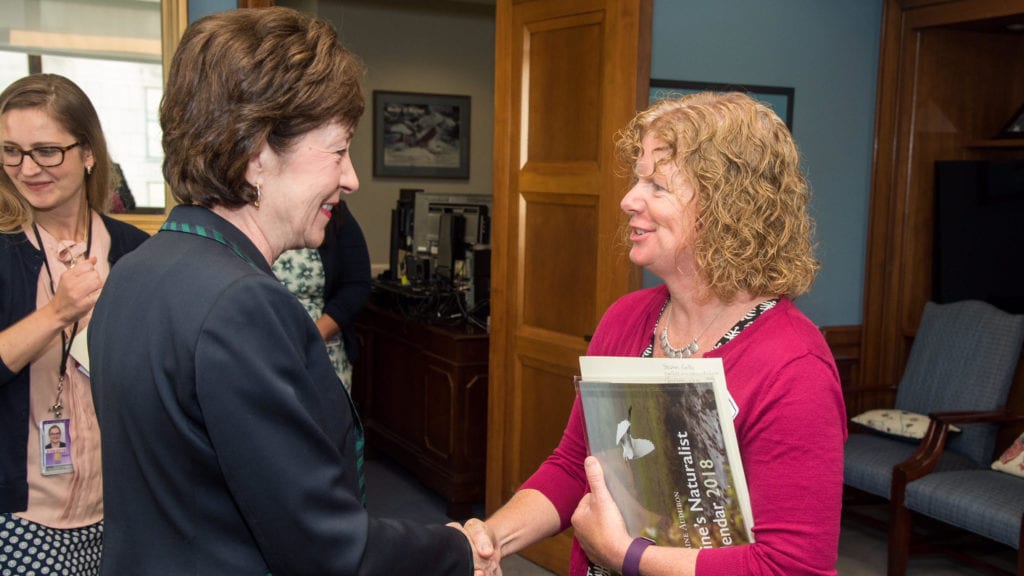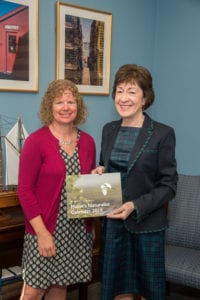
Although Maine Audubon’s lens is usually (and rightly) focused on wildlife and habitat issues within the state of Maine, there are times when issues “from away” warrant our time and attention. The Arctic National Wildlife Refuge (ANWR) is one of those.
Maine is an unparalleled fall destination for visitors from near and far — and few farther than the fall shorebird migrants who hunker down on our coastal mudflats and beaches, fattening themselves up before continuing their epic migration over the Atlantic and down to South America. Some of these shorebirds, including Whimbrels and Short-billed Dowitchers, may come from as far away as Alaska’s ANWR, a 19 million-acre gem of wilderness and critical wildlife habitat.
That’s why I didn’t hesitate when National Audubon invited me to join the “Birders Fly In” at their DC headquarters. It was to be a quick, two-day trip to the beltway, with the goal of meeting with the Maine delegation and sharing our concerns about recent attempts to open up the refuge to oil drilling.
Day 1
I flew down on Monday afternoon and headed straight to National Audubon’s DC headquarters, where we had a working dinner and multiple presentations by scientists and policy experts familiar with the long history of ANWR. The refuge was created by President Eisenhower in 1960, and has been expanded several times to its now 19 million acres. It includes the impressive Brooks Range in the south, and a 1.5 million acre coastal plain stretching north from the mountains to the Arctic Sea.
This area is home to more than 200 species of birds, as well as dozens of other species, including all three bears, moose, fox, wolves, and caribou. In fact, the vast caribou herd in the refuge uses the coastal plain during the critical time of calving each summer. It was a lot of information to take in, but take it in I did, as I prepared to meet with the Maine delegation the next day.
Day 2
This was an exciting day of moving between House and Senate offices and speaking with our elected representatives and their staff. It began with a sunrise walk down to the National Mall:
I met with Sen. Collins (who has a long history of supporting ANWR and opposing past efforts to open it to drilling), and friendly staffers in the offices of Sen. King, Rep. Poliquin, and Rep. Pingree (who has co-sponsored HR 1889 to designate the coastal plain as wilderness).

In each meeting, I focused on three big reasons we ought to keep oil exploration out of ANWR:
- ANWR is an amazing place for wildlife and for people. Drilling for oil, even with new technology like horizontal drills, leaves a sprawling industrial footprint that is simply not compatible with quality wildlife habitat. Research has shown that caribou and other wildlife avoid pipelines and other infrastructure association with drilling. And in addition to the native Gwich’in tribe, which has long refused monetary rewards for drilling rights on their ancestral lands within ANWR, the refuge is a major eco-tourism destination. Nature-based tourism in the area is thriving — and it relies in large part on a coastal plain that supports diverse and healthy wildlife populations.
- Drilling for oil and gas in ANWR does not make economic sense. Oil and gas lobbyists are not asking congress to open ANWR to drilling, because the numbers don’t add up. All-time low gas and oil prices, combined with abundant natural gas exploration and development in other places (as well as the proposed high lease rates in the refuge), makes additional drilling in ANWR a losing economic bet. Especially since there are still hundreds of leases available in the rich grounds west of the refuge!
- This is too big a decision to be slipped quietly into the budget. While doing so means it could pass with only a simple majority in the Senate, that is not how such a momentous decision should be made. ANWR belongs to all the people in the United States, and we should all have a say in how it is managed. The refuge’s Comprehensive Plan — completed in 2015 by natural resources managers with feedback from more than 90,000 people — calls for moving the area of the coastal plan ahead as a designated wilderness. This is what we want to see…not drills and industrial development.
I appreciated having the opportunity to make this case to our Maine delegation. I also really enjoyed this trip — it was interesting to see the workings of our federal government up close, and the value and impact of having people from far-flung corners of the country speaking with their delegations about the same thing, and with a unified voice, was really clear.
Hopefully this critical habitat will continue to receive the protection it needs and deserves! If you want to lend your voice, at the moment the best thing to do is to contact Sens. Collins and King and ask them to support an amendment to the budget that would remove drilling in ANWR. Thank you!
